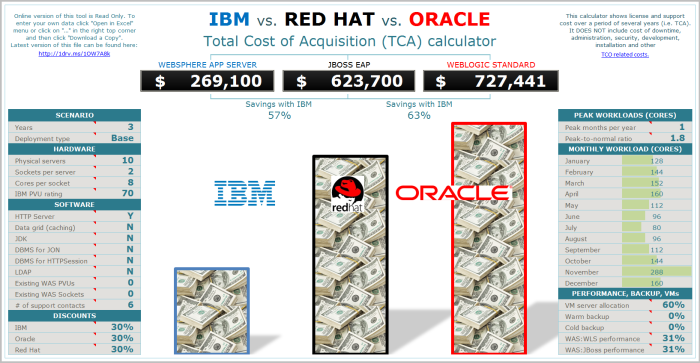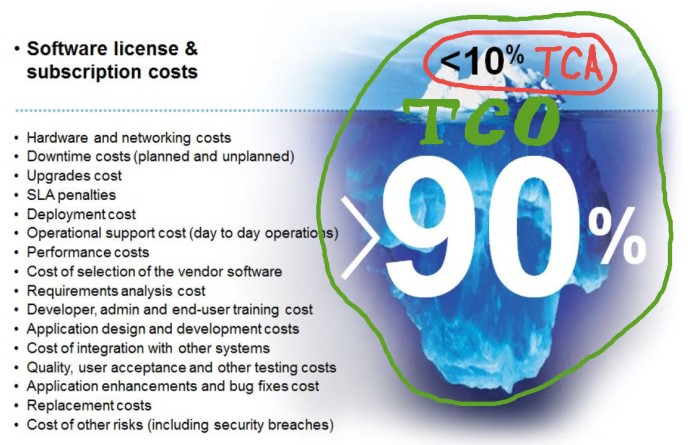Updated on August 4, 2016 with new pricing, license terms and updated XLS file.
On July 12, 2016 IBM has made available new term license and pricing for WebSphere Application Server, which made it even more cost competitive compared to JBoss and WebLogic and more friendly for variable workloads. This new license model does not replace the perpetual PVU pricing, but it replaces the old term pricing (yearly and monthly PVU) – it is called Virtual Processor Core (VPC).
You can find a more detailed description of this new VPC and other types of licenses in my recent blog post: “Comparison of cloud and on-premise license types for WebSphere, WebLogic, JBoss and tc Server”.
I updated the cost calculator to reflect new VPC licensing and you can easily compare cost of license and support for IBM WebSphere Application Server (Liberty and traditional), Red Hat JBoss EWS and EAP, and Oracle WebLogic. Please note that this calculator compares Total Cost of Acquisition (TCA), not a Total Cost of Ownership (TCO).
For those of you who can’t wait to start using it, just click here to open the spreadsheet. Please note that when you open it in your browser it is Read Only, but if you prefer to enter your own numbers, you can download it to your disk and open in Excel. Tabs are protected for ease of use, but you can easily un-protect them if you want to see or edit formulas, just go to Menu->File->Unprotect (no password required – I have nothing to hide since all of this is based on publicly available information). Click on the image below to open the spreadsheet – all of the data entry is done on this page shown below:

I also recorded an instructional video that explains how to use the calculator (the video is based on a slightly older version of the calculator, but is 90% the same):
As I said earlier, this post and the calculator are about the Total Cost of Acquisition (TCA), not about the Total Cost of Ownership (TCO). In other words, the calculator above only helps you figure out the cost for the tip of this iceberg shown below, however – do NOT ignore the TCO. It is the elephant in the room.

Red Hat promotes JBoss Application Server as a low cost alternative to WebSphere Application Server Network Deployment (WAS ND) and WebLogic Enterprise, but this is like comparing Ford Focus and Ferrari 458. Well, why not? Both have a lot of similarities:

Similarities:
|
Differences:
|
I am not saying that WebSphere = Ferrari and is super expensive and needs maintenance all the time (no analogy is ever perfect). My point is that one must compare similar capabilities and qualities (as discussed in this post), not just compare prices in complete isolation from those qualities. Why does Red Hat compare the cost of JBoss EAP to WAS ND? Well, it makes JBoss pricing look relatively good. There are major differences between these products in terms of features and qualities as I have discussed it many times on this blog. A proper comparison would be between JBoss EAP and WebSphere Application Server (unofficially called “base” version), not WAS ND.
If you would like to do your own math, feel free to download a copy of the Excel spreadsheet above and play with numbers. As you can see, WAS provides huge cost savings compared to JBoss EAP and that is not even considering other elements of the Total Cost of Ownership (TCO), such as administration, reliability, scalability, failover, security, etc. If somebody few years ago would have told me that WAS will cost less than JBoss EAP I would have laughed. But such are competitive pressures on the market that over the past several years IBM has made very aggressive moves in the application server space with lowering WebSphere prices via socket based licensing and new VPC, adding HTTPSession failover, removing WLM and clustering restriction, adding Job Manager feature, bundling Full Liberty Profile with WAS Base and ND, and a number of other capabilities. All of this resulted in a lower cost, higher quality WebSphere Base product compared to JBoss EAP. Not to mention WAS ND.
The calculator in the spreadsheet above shows pricing options for WebSphere Application Server (different editions):

As you can see, you do not need to buy WAS for peak workloads – you can buy it for on-prem deployment for 1 month to handle peaks. For cloud deployments you can also buy WAS for 1 hour. You can also buy WAS based on number of users, cores, sockets, etc. Oracle, Red Hat and others offer some, but not all of these options. As I already mentioned, you can find a very detailed description of various license types in my recent blog post: “Comparison of cloud and on-premise license types for WebSphere, WebLogic, JBoss and tc Server”.
As an additional consideration, WebSphere includes certain components needed to run a real application, while JBoss and Tomcat require those to be purchased separately (the XLS document above does include these costs):

Notes:
* – Load Balancer and Caching Proxy are not included with WAS or Liberty Core;
** – WebSphere eXtreme Scale full function is provided with WAS ND, but is limited to HTTPsession cache and Dynacache in WAS Base, and is not provided in Liberty Core.
The result is that WAS Liberty Core, and WAS Base cost less than JBoss or supported versions of Tomcat – even if you completely ignore true TCO and only compare license and support costs. Here are few highlights of features that are similar between WAS and JBoss EAP:
- Full Java EE 6 and 7 certification;
- Free development license;
- WLM support for HTTP protocol with web server plugin;
- Clustering and failover for HTTPSession;
- Management of multiple servers from a single location (albeit in both cases it is way more limited than what is available in WAS ND);
- Startup and application deployment times are very similar.
At the same time there are few differences between WAS and JBoss EAP, some (not all) are listed below:
- WAS has much more flexible license options for on-prem and cloud deployments (both the full profile and its built-in Liberty profile) and can be licensed either by cores or by sockets, as perpetual license, or as a term license for an hour or month. JBoss EAP license options are way more limited as I documented in this article;
- IBM support for WAS includes unlimited support contacts, while with Red Hat it depends on the number of cores licensed (2 contact for up to 32 cores, 4 contacts for up to 64 cores, etc. up to 12 contacts for 160 cores);
- WAS includes software and support for JDK, Data Grid (WebSphere eXtreme Scale), HTTP, LDAP, DB2 (for HTTPSession persistence) while JBoss EAP does not includes these and requires additional purchase from Red Hat and 3rd party vendors;
- WAS runs average application about 31% faster than JBoss EAP (according to dozens of customer benchmarks and IBM in-house tests I have been involved with);
- WAS offer richer programming model and has some APIs not provided by JBoss, such as SIP, Portlet, WS-Notification, WebRTC;
- WAS license includes Liberty Profile, which provides much smaller footprint compared to JBoss EAP;
- JBoss EAP has EJB failover while WAS Base does not – however most customers are not using EJB failover capability and vast majority of applications are either keeping their state in a database or are stateless;
- JBoss EAP does not support SuSe (on any platform), OS/400, AIX/POWER, z/OS, SuSe or RHEL on zSeries, while WAS supports all of these;
- see many additional differences in this Slideshare deck and YouTube video.
There are other differences between the products, but from the description above you can see that overall WAS provides quite a bit more capabilities compared to JBoss EAP.
If you want to save money (and who doesn’t?), why not migrate from JBoss EAP to WAS? After all, IBM has free automatic migration tool and offers free migration workshop, so you can get up and running on WebSphere Application Server in no time. Later, when and if you need Ferrari (aka WAS ND), you can upgrade to it from WAS with no migration required – simply federate your nodes into WAS ND cell and you get yourself a whole new world of Intelligent Management, SLA enforcement, dynamic clusters and so much more! If you are using Liberty – just add your standalone members to a collective or to a cluster and start taking advantage of Intelligent Management features.
Categories: Cost & Licensing, IBM MQ, Messaging, Technology
 Updated IBM MQ vs. Red Hat JBoss A-MQ cost calculator and video
Updated IBM MQ vs. Red Hat JBoss A-MQ cost calculator and video  Forrester Research discusses its new Total Economic Impact study for WMQ vs. Open Source
Forrester Research discusses its new Total Economic Impact study for WMQ vs. Open Source
I have been running JBoss EAP for 3 years now (16 cores) at an annual subscription cost of $7,500. I priced WebLogic and WebSphere and both cost a fortune in comparison at the time. I believe I have the original quotes from IBM/Oracle. If you believe I can license WebSphere (16 cores) for less than $7,500 hook me up.
LikeLike
Kevin, you can get WAS Base for less than JBoss, but not in the configuration you are using. You are not using 24×7 support, only have 2 support contacts, no http server, not considering WAS performance advantage (usually ~30%) etc. If you use my calculator you can see that in most cases (not all) WAS Base is indeed cheaper – in some cases by a lot.
LikeLiked by 1 person
Kevin, with the new VPC pricing announced by IBM on July 12, 2016 with WAS Liberty Core you pay $7,000 per year – cheaper than JBoss.
If you are using less than 16 cores (I assume you are, since 16 cores is a minimum JBoss bundle), then you can get WAS Liberty Core for less than $7K.
For WAS Base you will pay just a little bit more – around $12K, but per my other comment you get higher level of support, more performance and few other things with it. And you can buy less than 16 cores, in which case it will be cheaper than your JBoss subscription (you will double your cost to $15,000 if you need 17 cores – and WAS Base will be definitely cheaper than that for 17 cores !!!).
LikeLike